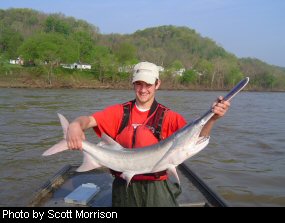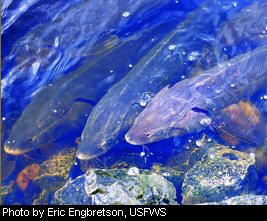

West Virginia’s “Throwbacks”By Dan Cincotta
Now some of you are probably thinking, I've never heard of these fishes before. Well, since these fishes are rare in West Virginia and live in our larger rivers, you probably wouldn't recognize them or their names. I'll bet, however, that if you ever see one you'll remember what they look like, probably for the rest of your life. These fishes are so distinctive, you could almost guess they're primitive, or as scientists refer to them -- evolutionary “throwbacks.” There's that word again, but this time “throwback” means that these modern day animals had prehistoric ancestors roaming, or in this case, swimming the earth. Paddlefishes and sturgeons are the only living representatives clas sified in the fish order Acipenseriformes , which science considers the oldest surviving group of bony fishes. The living and dead representatives of these fishes have been part of fossil history for at least 200 million years. The fact they are assigned to the same fish order implies that these animals share characteristics that make them related. These species are in different families, however, which usually means they don't look alike, and believe me, they do not look at all alike! The anatomical features these fishes share include a largely cartilaginous skeleton, with only a few bony parts, a long vertebral column that extends through the upper lobe of the tail fin, a spiral valve intestine, whiskers, called barbels, near their mouth, and either no rays or one ray in the flap that protects the gills. Before we get into a lot of specific facts on sturgeons and paddlefishes, let's put the words “primitive” and “prehistoric” into perspective with regard to fishes and animals in general. Science recognizes approximately two million animal species worldwide and this number barely scratches the surface of how many animals are really on earth. The first prehistoric invertebrates, or animals without backbones, are thought to have existed 1.8 billion to 550 million years ago. Vertebrates, animals with backbones, namely fish, birds, reptiles, amphibians and mammals, number less than two percent of all known animal life. Primitive vertebrates, of which jawless fishes were the first, started appearing in fossils approximately 500 million years ago. As you might expect, since fishes were the oldest animals and have been around longer, they have evolved into the largest vertebrate association totaling at least 25,000 species. Birds are a distant second with only 9,000 representatives. This number of fishes does not even include numerous species that have become extinct. The 24 species of sturgeons and two paddlefish species that exist today have adapted, survived, and retained certain physical characters in the world's changing environment for at least the last two hundred million years. Hence, they look now much as they did then. Sturgeons are restricted to the Northern Hemisphere and have both anadromous and freshwater representatives. Anadromous means that some species are like salmon, which live in the ocean and return to spawn in freshwater. West Virginia historically had two native freshwater representatives that did not migrate to the ocean. They were the lake and the shovelnose sturgeons. All sturgeons have five rows of bony body armor called scutes, four fairly long barbels or whiskers immediately in front of the mouth, and no rays or one ray in the flap that protects the gills. The snout is prominent, but nothing like its paddlefish relative. The sturgeon's mouth, located on the underside of the head, has telescoping, fleshy lips, which assist feeding on their main diet of bottom-dwelling food like crayfish, mussels, snails and insects. Sturgeons are prized worldwide and are harvested for their delicious white meat and even more so for their eggs, which are used for caviar. They are the largest of all freshwater fishes. Some species are very long-lived and large, like the Beluga West Virginia 's largest species, the lake sturgeon, has not been seen here since at least the 1940s. Although we have little data for this fish, it has been documented elsewhere to live for over 150 years, and grow to 8 feet in length and weigh 300 pounds. Not all sturgeons are as long-lived or reach the sizes mentioned above. For example, our shovelnose sturgeon has a life span of approximately 13 years and reaches a maximum size of approximately 33 inches and 10 pounds. Our native sturgeon species vary in other ways besides size. This is especially noticeable in their preferences of habitat. The lake sturgeon thrives, as its name implies, in large standing water or slow-moving river environments. The shovelnose on the other hand, does best in faster flowing rivers. Spawning for both species occurs in spring over rocky or coarse substrates, like the majority of our freshwater stream fishes. The numbers of eggs produced by these fishes, depending on the size of the female, range from 10,000 to 50,000 for the shovelnose and 50,000 to 700,000 for the lake sturgeon. The female lake sturgeon, however may produce as many as 3 million eggs. Let's move on to those paddlefishes with their bizarre paddle-like snouts. The paddlefish family is represented by only two living species and both are entirely freshwater inhabitants. One species is found in North America , where it was found historically in Lake Erie and presently throughout the Mississippi and Gulf Coast drainages. The second species is a giant Asian fish, historically reported to have reached 23 feet, but recent specimens do not exceed nine feet. It is known only from the waters of China . The species found in West Virginia is a weird looking creature and was originally described as a shark in 1792 due to its virtually scaleless body and predominantly cartilaginous skeleton. After close inspection, however, it was found to have some scales and bony structures, and consequently was removed from being classified with the shark. Our paddlefish has also been mistaken for a catfish by some anglers as this species is sometimes referred as a spoonbill catfish. This name is probably derived from the small barbels found on the “spoonbill” or the paddle, and its gray, bulky catfish-looking body. You may wonder what the paddle is for. To explain this structure you must first know that this large fish, which reaches a maximum length of nearly seven feet and a weight that may exceed 180 pounds, is a filter feeder. This explains the large mouth found under the base of the paddle that is used to strain tiny plants and animals from the water. Scientists believe that the paddle, which is underlain with an extensive network of sensory organs and is often about a third of the fish's length, is used to locate concentrations of microscopic “food.” It is also thought that the paddle helps stabilize the fish horizontally while feeding. North American paddlefish are primarily big river fish but apparently have adapted quite well to manmade lakes and commercially navigable rivers. During spring they prefer to migrate up large streams and rivers where they spawn in fast currents over gravel and larger rock substrates. Depending on their size and age, females usually generate between 10,000 and 50,000 eggs, but large individuals may produce more than 500,000. Although fairly long lived, paddlefish do not survive nearly as long as many sturgeon species as their maximum age rarely exceeds 20 years old. As you can see, these species that look so very different share many aspects of life history. Be that as it may, you might think that if one of these unique species was in jeopardy, all of them might be vulnerable. This is the case for West Virginia 's three species and many other populations of paddlefishes and sturgeons throughout the United States and the rest of the world. Populations of these species have declined drastically due to pollution, habitat alterations and over-harvesting. To complicate matters, these species have certain life requirements that work against their survival. Specifically, males and females in both groups take several years to sexually mature, approximately five years for the shorter-lived species and between 12 to 20 years for the longer-lived ones. To make matters worse, females, and sometimes males, may not spawn every year after maturity. To increase their chance of survival and to restore these special species to our state fauna for the enjoyment of all West Virginians , the DNR Wildlife Resources Section has been stocking paddlefish and shovelnose sturgeon in state waters. The decision to stock the rarer lake sturgeon has not yet been made. Stocking is coordinated with fish and wildlife agencies in Kentucky , Indiana , Illinois , Ohio and Pennsylvania . To make this program successful throughout the Ohio River basin , we need your help. Please do your part in the re-establishment of these unique species to West Virginia and the surrounding waters by telling people about these unique native and protected “throwbacks.” Perhaps with a little luck and the cooperation of all who might encounter these species while angling, we may one day have self-sustaining populations of these magnificent fishes and restore a heritage that is much, much older than West Virginia itself. Dan Cincotta is a fisheries biologist stationed in Elkins. |
 To an angler who wants to catch and harvest fish, the word “throwback” is probably the most frustrating word in the English language. Of course, it means they have to release their catch, unharmed, back into the wild. The reasons for having to do this may be varied. It may be that the fish was caught in a catch-and-release area, or it may be under a certain size or in a slot-limit requirement. Another reason that doesn't occur very often, but is as important as any fishing regulation, is related to the immediate release of rare fish. In West Virginia , three fishes are protected with this special designation -- the paddlefish and the lake and shovelnose sturgeons.
To an angler who wants to catch and harvest fish, the word “throwback” is probably the most frustrating word in the English language. Of course, it means they have to release their catch, unharmed, back into the wild. The reasons for having to do this may be varied. It may be that the fish was caught in a catch-and-release area, or it may be under a certain size or in a slot-limit requirement. Another reason that doesn't occur very often, but is as important as any fishing regulation, is related to the immediate release of rare fish. In West Virginia , three fishes are protected with this special designation -- the paddlefish and the lake and shovelnose sturgeons.  sturgeon of the Caspian and Black seas. This sturgeon may attain a length of 26 feet and weigh up to 2,800 pounds.
sturgeon of the Caspian and Black seas. This sturgeon may attain a length of 26 feet and weigh up to 2,800 pounds.